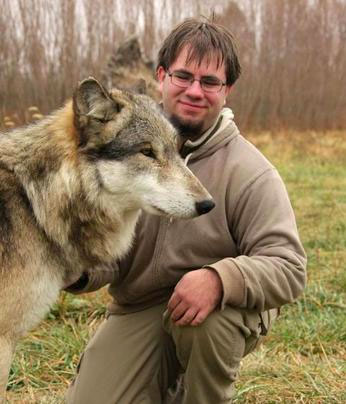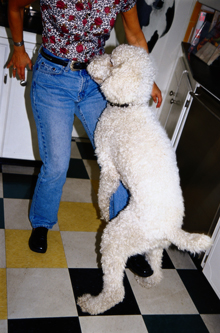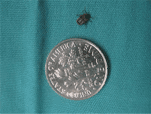Why Is My Female Dog Humping?
Nick Hof, Certified Dog Trainer
 Usually humping is associated with male dogs, but humping is also very common amongst female dogs. Some girls will hump toys or other objects, some hump air, while others hump other dogs or even people. We talk with Certified Professional Dog Trainer and Chair of The Association of Professional Dog Trainers Nick Hof, CPDT-KA, CBCC-KA, KPA-CTP, CSAT, to answer some of your most commonly asked questions about female dogs and humping.
Usually humping is associated with male dogs, but humping is also very common amongst female dogs. Some girls will hump toys or other objects, some hump air, while others hump other dogs or even people. We talk with Certified Professional Dog Trainer and Chair of The Association of Professional Dog Trainers Nick Hof, CPDT-KA, CBCC-KA, KPA-CTP, CSAT, to answer some of your most commonly asked questions about female dogs and humping.
Humping comes really naturally to even female dogs, but it is probably the most awkward behavior for people to witness - or be subjected to. So why do they do this? There can be many different reasons why female dogs might hump. One of the things, whenever we're looking at any kind of behavioral issue or thing that we're looking to change, we always want to look at the context of the behavior and try to figure out what seems to be fueling it or motivating that behavior. However, some of the different common reasons why female dogs hump, may be due to just getting overexcited and aroused. Not necessarily in a sexual capacity, just the excitement of certain situations can cause that to happen. We can also see it from some dogs as a stress response or reaction. There may be other reasons as well.
Nick explains that we sometimes do see mounting, as it relates to some kind of assertive behavior. But very often, at least in his experience, if we are looking at a dog that is trying to assert themselves, that's actually usually going to be devoid of the humping action. It's usually going to be just the mounting itself and it looks very different from a dog that is just excitable.
Does spaying a female dog make a difference and will it stop the humping? In Nick's experience, it does not. Most of the female dogs that he's met who are humpers do tend to be spayed, but he thinks that's just because the vast majority of dogs that he works with tend to be altered.
 Nick personally had two female dogs who would do this quite a lot, especially whenever he would have guests over, which was great for a trainer! Anytime anyone would come over, they would just be so excited and so happy at having someone over that they would sort of turn on each other and just start humping each other a little bit.
Nick personally had two female dogs who would do this quite a lot, especially whenever he would have guests over, which was great for a trainer! Anytime anyone would come over, they would just be so excited and so happy at having someone over that they would sort of turn on each other and just start humping each other a little bit.
When your dog does start humping, should you stop them? Nick says if it's a problem for you, you can redirect and try to interrupt this behavior. So in the case with his two dogs, he looked at it from his perspective and it wasn't an issue. They weren't upsetting one another. It wasn't causing any other issues. It didn't really particularly bother him, so he didn't worry about trying to interrupt it.
But certainly when your dog is doing that to a guest or to you, that can be quite embarrassing and uncomfortable, so you can try to interrupt it and redirect it. Very often Nick tries to figure out if he can predict that it's going to happen and try to be proactive with his training. So for example, with his own dogs, when he has someone come over, something really simple he can do is to ask his female dogs to do a down stay on their beds while the guest came in and get settled down.
So by preemptively asking your dog to do something that you'd like them to do, maybe that is to sit, lay down or fetch, then you are telling the dog what you'd like them to do in that moment as opposed to waiting for them to begin the inappropriate behavior and then trying to redirect it.
One thing that can happen from time to time is when we make a point of trying to stop a behavior that we don't want, if that becomes an easy way for them to get attention, then it can become a learned behavior and a little trick for them to get what they want. Because they go, oh, well, if you ignore me and I hump you, that gets your attention immediately.
 Dr. Debbie tells us that she hears stories from her clients who will say that their dog is starting to mount the children or the wife. How should they be counseled? Could this be a precursor to a more of a dominant situation, something we need to intervene for the sake of the household harmony? Or, should it dismissed as kind of a playful thing?
Dr. Debbie tells us that she hears stories from her clients who will say that their dog is starting to mount the children or the wife. How should they be counseled? Could this be a precursor to a more of a dominant situation, something we need to intervene for the sake of the household harmony? Or, should it dismissed as kind of a playful thing?
For most people, Nick fells they should go into counseling and work to change that behavior, regardless of whether it is mounting, which may be more concerning, versus humping. Most families aren't going to want that behavior regardless of what the motivation is.
Nick says what they do as professionals is to try to get a little more information about the context or what the behavior looks like, which can help them figure it out. Some of the questions they ask is when your dog mounts, is it gyrating or just holding still? Is it an exciting situation? Does it cause you concern? Is your dog able to be redirected or interrupted from this behavior? And if not, what happens when you try to interrupt them? So for example, if you had a dog who was maybe mounting in a little bit more of a concerning behavior, if you tried to interrupt them or redirect them, we might find that the dog may kind of respond a little bit aggressively in response to that. That would be a very clear signal that we want to get a professional in there who can help to assess the situation and give proper and appropriate advice to prevent that from escalating into a more concerning issue.
The website, The Association Of Professional Dog Trainers, has great information on general training issues and great resources for finding trainers to help you with any issues that you might be having with your dog.
Visit Website
Bi-lingual Dog Comforts Homeless Kids
Guillermo 'Memo' Roa & Molly
 Molly is a bilingual chocolate lab. She responds to direction in both English and Spanish. Her trainer, Memo, escaped Mafia violence in Columbia and came to the US where he founded a dog training business. They are a certified therapy team that has helped so many children in homeless shelters. Because of their bilingual abilities and Memo's deep understanding of what it is like to be thrown into a new culture, they are bringing unprecedented joy to children in desperate situations.
Molly is a bilingual chocolate lab. She responds to direction in both English and Spanish. Her trainer, Memo, escaped Mafia violence in Columbia and came to the US where he founded a dog training business. They are a certified therapy team that has helped so many children in homeless shelters. Because of their bilingual abilities and Memo's deep understanding of what it is like to be thrown into a new culture, they are bringing unprecedented joy to children in desperate situations.
So why does Molly need to know two languages? Memo said there's a fun history behind it. When he was training her in basic obedience, he explained to her owner, June, in English the basic commands of sit, come and down and told her how to give these commands to Molly. However, when it was just Memo and Molly alone in a training session, it was easier for him to speak his own language. So he always spoke to Molly in Spanish.
One day June told Memo that when her housekeeper talked to Molly in Spanish, Molly listened very well. June then asked Memo if he actually spoke to Molly in Spanish. Memo admitted to her that he did speak Spanish to Molly. This was a big surprise to June, who started laughing. Now, June tells everyone that her dog can speak two languages and Memo continues to speak to Molly in both languages.
Having a bilingual dog can be great and a lot of fun, but in reality, the dog doesn't really know the difference between the languages. What happens is that the dog is picking up on the cues that go with the language that is being spoken.
Memo states that when you use the verbal commands and when you use your body language, the dog is going to learn easier by your body language. So when you tell a dog to sit or to stay down, whether you say it in English or Spanish, you move your body and the dog listens to your body. So no matter what language or what sounds are coming from your mouth, if the dog is looking at you, he's going to understand what you are saying no matter what language you use.
 Memo and Molly are a certified therapy team that has helped many children in homeless shelters. Because of their bilingual abilities and Memo's deep understanding of what it is like to be thrown into a new culture, they are bringing unprecedented joy to children in desperate situations. When the homeless kids realize they can connect with Molly in their native language and this pair really understands them, they light up and find new hope.
Memo and Molly are a certified therapy team that has helped many children in homeless shelters. Because of their bilingual abilities and Memo's deep understanding of what it is like to be thrown into a new culture, they are bringing unprecedented joy to children in desperate situations. When the homeless kids realize they can connect with Molly in their native language and this pair really understands them, they light up and find new hope.
Two places that they volunteer at are the Covenant House and Bethany House. At the Covenant House, Memo says the people there are abused and homeless and are people that need the company and the direction of somebody else. Both venues work wonderfully for Molly, as she is able to provide comfort and spend quality time with a wide spectrum of people from children to adult patients in need. Some of these people need confidence, they need compassion and they need company.
The patients at these places excitedly wait for Molly to come. When they actually do see Molly, you can actually see the change in their faces and you can see how happy they are. Then, when Memo uses his Spanish with Molly, they look at him and say, "Really, the dog is speaking Spanish?" Memo doesn't want to tell them the Molly really doesn't understand the words, so he says, "Yes! Of Course! Talk to her in Spanish."
Memo says the main goal for him and Molly is to help people and to have fun.
Visit Website
Ticks Hitchhike on City Dogs Too - Dr. Debbie
 Ticks are common parasites known to infect people, pets and spread disease. Over 850 tick species exist worldwide, although fewer than a dozen species are of risk to pets in the U.S. But here in Las Vegas, pet owners often dismiss the existence of ticks with the likes of Bigfoot or the Loch Ness Monster. Think ticks are only a problem for pets that travel or visit the mountains? Think again.
Ticks are common parasites known to infect people, pets and spread disease. Over 850 tick species exist worldwide, although fewer than a dozen species are of risk to pets in the U.S. But here in Las Vegas, pet owners often dismiss the existence of ticks with the likes of Bigfoot or the Loch Ness Monster. Think ticks are only a problem for pets that travel or visit the mountains? Think again.
The Tick Tale
Ticks are parasites known to infect mammals, reptiles and birds and feed on their host's blood. Although of tiny size, ticks ingest 200 to 600 times their weight in a blood meal.
Ticks are attracted to a host's movement, body warmth or exhaled carbon dioxide and then latch on. Through this feeding behavior they can transmit diseases to pets such as Lyme disease, Rocky Mountain spotted fever, Ehrlichia, Babesia and Tularemia. Disease transmission takes some time and may occur after 36 to 48 hours of feeding behavior.
Some ticks can live months or up to a year off its host without a feeding, so year-round prevention is important for pets at risk for continued exposure.
Battling Ticks
There are many topical tick control products available for pets. Speak with your veterinarian for an product that is effective and safe with your pet's individual health in mind. Cats are sensitive to some ingredients, may develop toxicity, and should never be treated with a product labeled only for dogs. Additionally, pet owners using multiple products on their pet should first consult with their veterinarian to ensure safe use of combined products.
In addition to topical tick control, environmental treatment with foggers, sprays or pest control service should be considered for heavy infestations. Limit tick habitat zones by maintaining landscaping, avoiding overgrown grass and keeping shrubs and plants trimmed.
Pet Screening
Perform daily tick checks during tick season. Examine your pet for ticks in areas that the parasites hang out - around the head, behind ears, armpits and between toes.
 When removing a tick, avoid handling it directly. Wear gloves or handle with Kleenex since ticks can pass infections to people as well. Grasp the tick with tweezers close to the skin. Extract the tick by pulling straight out of skin. Don't squeeze, twist or leave any legs behind. Disinfect the area and dispose of ticks in rubbing alcohol.
When removing a tick, avoid handling it directly. Wear gloves or handle with Kleenex since ticks can pass infections to people as well. Grasp the tick with tweezers close to the skin. Extract the tick by pulling straight out of skin. Don't squeeze, twist or leave any legs behind. Disinfect the area and dispose of ticks in rubbing alcohol.
Here's a photo of a typical tick, born and bred in Las Vegas and recently extracted from one of my Shih Tzu patients named Kane. Kane never leaves the state, doesn't hike in the mountains, and enjoys the comforts of a house-dog lifestyle. A tick was discovered on Kane after a day of supervising his owner's yard work and shrub trimming.
Maybe Kane's story will be an eye-opener for city dwelling pet owners. Pet parasites like fleas, ticks and mosquitoes still lurk in that urban jungle.
Visit the Dogs & Ticks website for more information ticks, diseases and prevention.
Featured veterinarian known as "Dr. Debbie" on national pet radio program, Animal Radio. Ebook author of "Yorkshire Terriers: How to Be Your Dog's Best Friend"; "Pugs: How to Be Your Dog's Best Friend"; "Mini Schnauzers: How to Be Your Dog's Best Friend"; and "Shih Tzu: How to Be Your Dog's Best Friend." Dr. Debbie's books.
Visit Website
Animal Radio News - Lori Brooks
 Pet's Needs In Divorce Addressed With New Bill
Pet's Needs In Divorce Addressed With New Bill
Another state may soon have a law that will deal with a family pet with greater concern than they have been given. In Pennsylvania, former attorney and now state Rep. Anita Kulik has introduced H.B. 1432, which would establish the new areas of concern for judges to consider when deciding guardianship of a pet in divorce cases. If the bill passes, the judge would be allowed to consider things like whether the animal was acquired prior to or during the marriage; the basic, daily needs of the animal; who generally gets veterinary care and social interaction for the animal; who deals with local and state regulations, such as licensing; and who has the greater ability to financially support the pet. As in most other states, Pennsylvania's current laws provide no special provisions for pets. The bill has been referred to the House Judiciary Committee for further consideration. This isn't a new idea; in 2017, Alaska became the first state to require the courts to consider the well-being of pets in divorce.
 Best Airlines When Traveling With Pets
Best Airlines When Traveling With Pets
A new report from WalletHub claims they've calculated the best domestic airlines for traveling with pets. They evaluated the nine largest U.S. airlines and three regional carriers across fifteen different categories using last year's data from the U.S. Department of Transportation. Among the bunch, Envoy Air (a subsidiary of American Airlines) and ExpressJet tied and were named the best carriers to fly with pets. Ten animals died during air transportation in 2018 and four major U.S. airlines had at least one pet fatality. Also four major airlines do not transport animals. Those are Frontier, JetBlue, Southwest and Spirit. When you're not taking pets into consideration, the report names Alaska Airlines as the best airline overall, Frontier Airlines as the cheapest and Delta Air Lines as the most reliable.
 Judge Dismisses Lawsuit Against Pet Food Company
Judge Dismisses Lawsuit Against Pet Food Company
A federal judge has dismissed a multimillion-dollar lawsuit filed against Ainsworth Pet Nutrition (which is owned by Smuckers) for alleged false and deceptive advertising of its Rachael Ray Nutrish dog food. The ruling allows the case to be re-filed if the complaint is modified. The suit, filed on behalf of a New York woman last August, sought at least $5 million in damages. It claimed Ainsworth's labeling of Rachael Ray Nutrish as natural food for dogs was false, deceptive and misleading. Independent laboratory tests found glyphosate, a chemical weed killer such as RoundUp, was present in the products. The judge said, "The presence of negligible amounts of glyphosate in a dog food product that do not have harmful, 'toxic,' or 'carcinogenic' effects is not likely to affect consumers' decisions in purchasing the product and is thus not material." Then for the same reasons, Judge Stanton dismissed the breach of warranty claim ruling, "A reasonable consumer would not interpret the label 'natural' as warranting that the products contain no amount of glyphosate."
 Wal-Mart Opens More Vet Clinics
Wal-Mart Opens More Vet Clinics
Wal-Mart is opening up dozens more veterinary clinics in its stores and launching its first online pet pharmacy, hoping to lure in more pet owners. The biggest retailer in the world already operates 21 veterinary clinics in its stores across six states. Over the next 12 months, it will increase that number to 100. They will start by opening nine new clinics in the Dallas-Fort Worth area where pets can receive vaccines, care for minor illnesses and other routine exams. Wal-Mart also will launch an online pet pharmacy filling prescriptions for dogs, cats, horses and livestock.
Pets Help With Loneliness
Owning a pet increases human interaction and combats the increasing health concerns around loneliness, according to researchers who recently presented their findings at the first Summit on Social Isolation and Companion Animals by Mars Petcare and the Human Animal Bond Research Institute. Among the findings, more than half of respondents say their pet helps them connect with other people and 51-percent said their pets make them "feel less shy;" about one in four pet owners said they got a pet because they know it is good for mental health, with more than half of people 55 and over getting a pet for that reason; and 73-percent of those surveyed believe nursing homes and assisted-living facilities have a degree of responsibility to foster pet interaction.
 Pet Store Lies About Where It's Animals Come From
Pet Store Lies About Where It's Animals Come From
The New York State Attorney General's office is investigating a pet store that it says lied to potential customers about where it got its animals. The store, Puppies & Kittens in Hartsdale, advertised that it only dealt with "certified breeders," when it was actually selling animals from large-scale commercial mills. The attorney general's office launched an investigation into the store in 2018 after multiple complaints from consumers who bought pets from the store that required treatment of illnesses commonly associated with animals bred at puppy mills, such as kennel cough, giardia, distemper and parvovirus. The store and the attorney general's office agreed to settle. As part of the settlement, the store is prohibited from making false representations about where it gets its animals and will have to pay a $7,500 civil penalty.
 Listen to the entire Podcast of this show (#1016)
Listen to the entire Podcast of this show (#1016)





